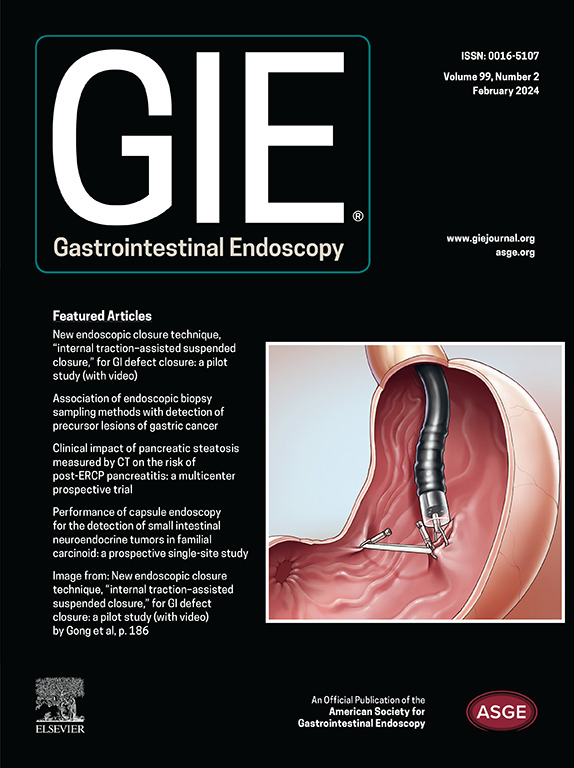Prospective randomized controlled trial of water exchange plus cap versus water exchange colonoscopy in unsedated veterans
IF 6.7
1区 医学
Q1 GASTROENTEROLOGY & HEPATOLOGY
引用次数: 0
Abstract
Background and Aims
Water exchange (WE) and cap-assisted colonoscopy separately have been shown to reduce pain during insertion in unsedated patients. We hypothesized that compared with WE, WE cap-assisted colonoscopy (WECAC) could significantly lower real-time maximum insertion pain (RTMIP).
Methods
Veterans without escort were recruited, randomized, blinded, and examined at 3 U.S. Veterans Affairs sites. The primary outcome was RTMIP, defined as the highest segmental pain (0 = no pain, 10 = most severe pain) during insertion.
Results
Randomization (WECAC, 143; WE, 137) produced an even distribution of a racially diverse group of men and women of low socioeconomic status. The intention-to-treat analysis reported results of WECAC and WE for cecal intubation (93% and 94.2%, respectively), mean RTMIP (2.9 [standard deviation {SD}, 2.5] and 2.6 [SD, 2.4]), proportion of patients with no pain (28.7% and 27.7%), mean insertion time (18.6 minutes [SD, 15.6] and 18.8 minutes [SD, 15.9]), and overall adenoma detection rate (48.3% and 55.1%); all P values were >.05. When RTMIP was binarized as "no pain" (0) versus "some pain" (1-10) or "low pain" (0-7) versus "high pain" (8-10), different significant predictors of RTMIP were identified.
Conclusions
Unsedated colonoscopy was appropriate for unescorted veterans. WE alone was sufficient. Adding a cap did not reduce RTMIP. Patient-specific factors and application of WE with insertion suction of infused water contributed to high and low RTMIP, respectively. For unescorted patients, selecting those with low anxiety, avoiding low body mass index, history of depression or self-reported poor health, and complying with the steps of WE can minimize RTMIP to ensure success of unsedated colonoscopy. (Clinical trial registration number: NCT03160859.)

一项前瞻性随机对照试验:在未绝育退伍军人中进行水交换加盖与水交换结肠镜检查。
背景和目的:水交换(WE)和帽子辅助结肠镜检查(CAC)可分别减轻无镇静患者插入时的疼痛。我们假设,与WE相比,WECAC可显著降低实时最大插入疼痛(RTMIP):在美国退伍军人事务部的三个地点招募了无陪护的退伍军人,对其进行随机、盲法检查。主要结果是 RTMIP,即插入过程中的最大节段疼痛(0 = 无痛,10 = 最剧烈疼痛):随机[WECAC(n = 143)和WE(n = 137)]产生了均匀分布的不同种族低社会经济地位男性和女性群体。意向治疗分析报告了 WECAC(列在第一位)和 WE(列在第二位)的结果:盲肠插管率[93%,94.2%];RTMIP 平均值(标清)[2.9 (2.5),2.6 (2.4)];无痛比例(28.7%,27.7%);插入时间[18.6 (15.6),18.8 (15.9) 分钟];总体 ADR(55.2%,62.8%),所有 P 值均大于 0.05。当 RTMIP 被二分类为 "无痛"(0) vs. "有些痛"(1-10),或 "低痛"(0-7) vs. "高痛"(8-10)时,发现了不同的 RTMIP 重要预测因素(见正文):结论:对无陪护的退伍军人来说,无痛结肠镜检查是合适的。仅有 WE 就足够了。结论:对于无人陪同的退伍军人,无麻醉结肠镜检查是合适的。患者的具体因素和应用 WE 并插入抽吸注入的水分别导致了高和低 RTMIP。对于无陪护的患者,选择焦虑程度低的患者、避免低体重指数、有抑郁症病史或自述健康状况不佳的患者,并遵守 WE 的步骤,可以最大限度地减少 RTMIP,确保无陪护结肠镜检查的成功。
本文章由计算机程序翻译,如有差异,请以英文原文为准。
求助全文
约1分钟内获得全文
求助全文
来源期刊

Gastrointestinal endoscopy
医学-胃肠肝病学
CiteScore
10.30
自引率
7.80%
发文量
1441
审稿时长
38 days
期刊介绍:
Gastrointestinal Endoscopy is a journal publishing original, peer-reviewed articles on endoscopic procedures for studying, diagnosing, and treating digestive diseases. It covers outcomes research, prospective studies, and controlled trials of new endoscopic instruments and treatment methods. The online features include full-text articles, video and audio clips, and MEDLINE links. The journal serves as an international forum for the latest developments in the specialty, offering challenging reports from authorities worldwide. It also publishes abstracts of significant articles from other clinical publications, accompanied by expert commentaries.
 求助内容:
求助内容: 应助结果提醒方式:
应助结果提醒方式:


